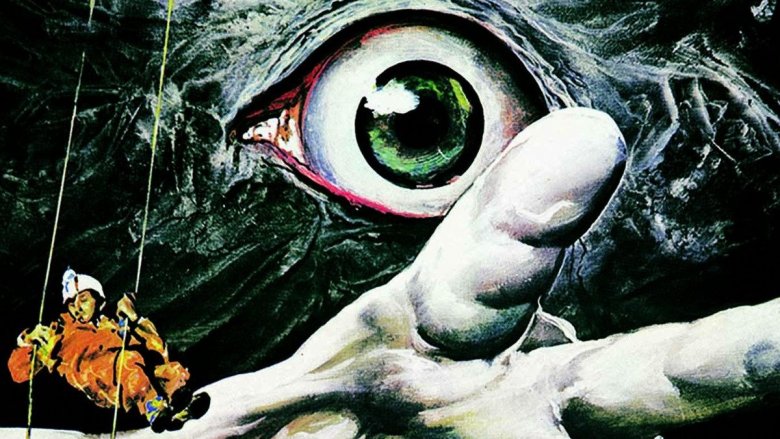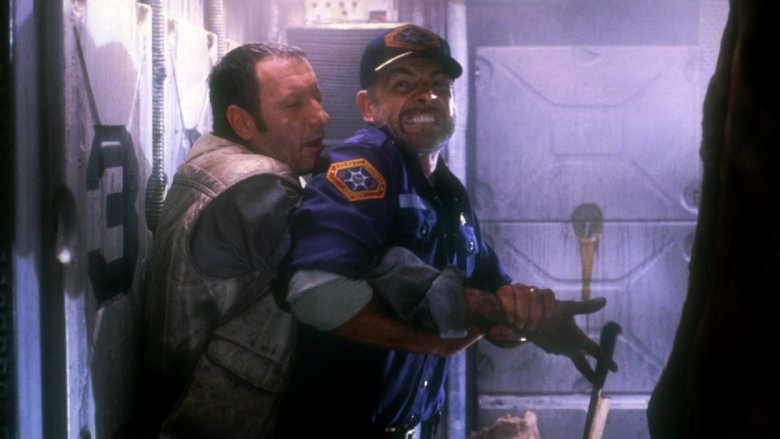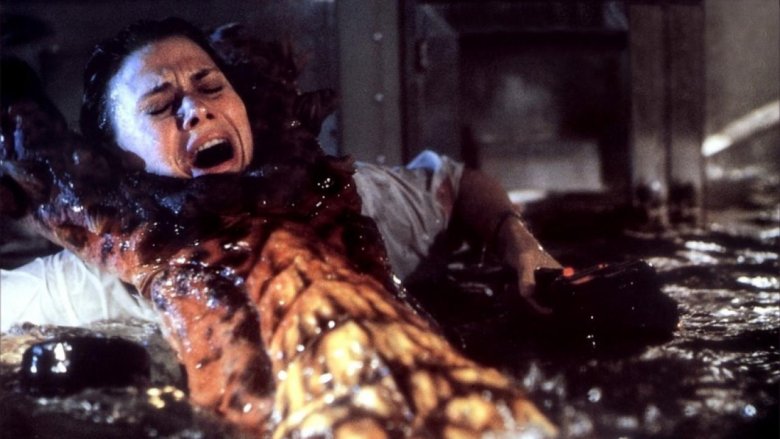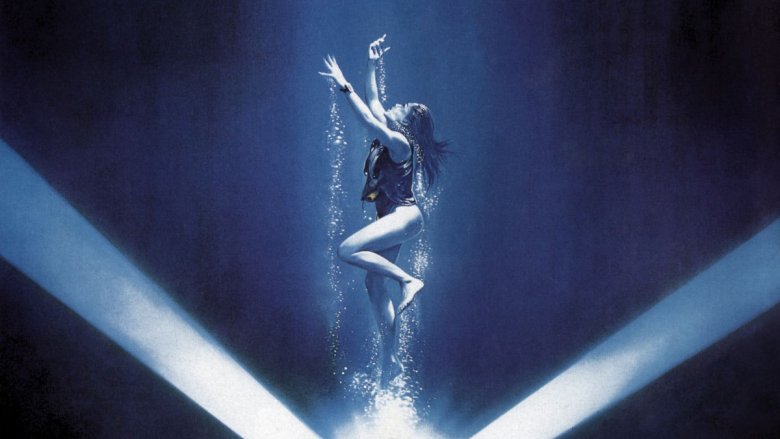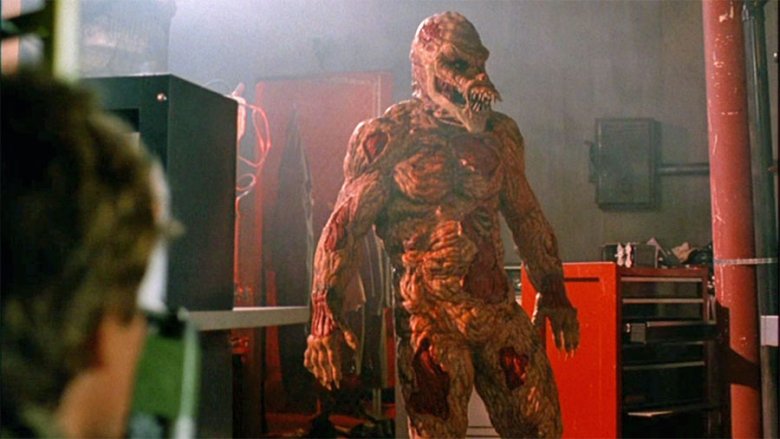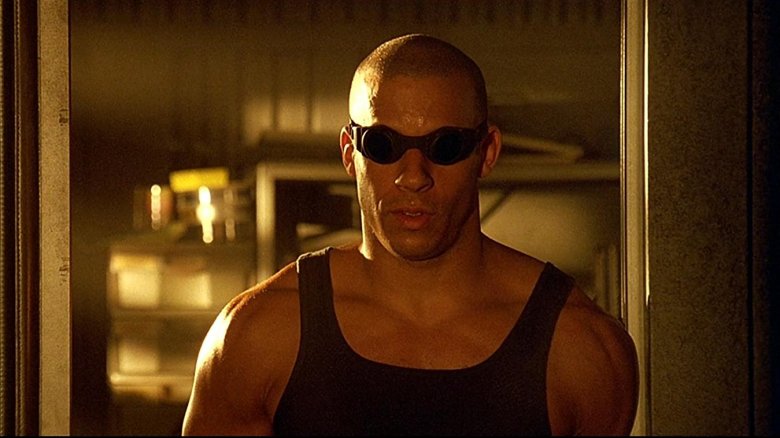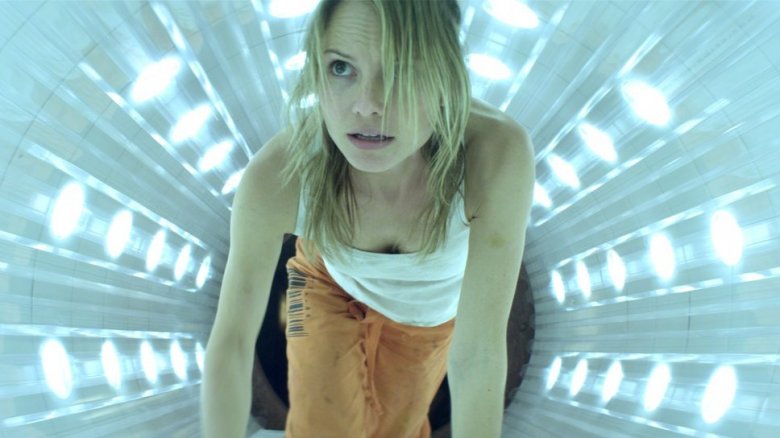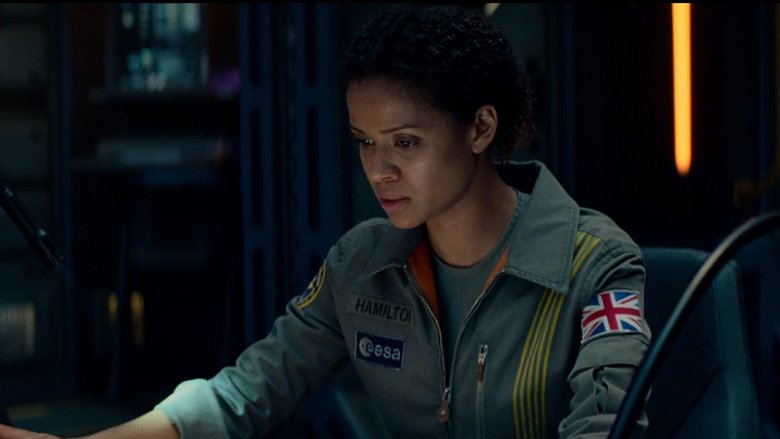Movies That Totally Ripped Off Alien
The foundation of the Alien franchise is an obsessive quest to distill the DNA of the "perfect organism," starting with Ridley Scott's 1979 classic Alien. Aboard the Nostromo, scientist and secret android Ash (Ian Holm) risked the lives of Ripley and crew to return a Xenomorph sample to Earth. More recently, in the 2017 prequel Alien: Covenant, synthetic David's quest for perfection inspired him to undertake chilling biological experiments.
Fittingly, filmmakers have mimicked this process by attempting to distill the DNA of Scott's perfect sci-fi horror. Its cinematic building blocks — claustrophobic production designs, overbearing and conspiratorial corporations, human-extraterrestrial insemination, and alien creatures exploding from the human body — have been duplicated consistently over the decades.
Pablo Picasso (allegedly) said "Good artists copy, great artists steal." By that definition, the films on this list should qualify as great. They've been heavily inspired by Scott's masterpiece and dissected it piece-by-piece to build something new. Some of them copy with subtle artistry, others with obvious nonchalance. But like the scientists aboard Alien: Resurrection's USM Auriga, each of the following films ripped off Alien, one way or another. Spoilers ahead.
Alien 2: On Earth (1980)
This low-budget Italian B-movie was an audacious — and almost immediate — attempt to piggyback on the success of Alien. Director Ciro Ippolito, using the pseudonym Sam Cromwell, made a canny (if morally questionable) move, releasing his film before Fox attempted to trademark the title Alien 2. According to Ippolito, director James Cameron couldn't use Alien 2 for his eventual Alien sequel because of this, and opted for Aliens instead. However, in Linda Obst's book Hello He Lied, Aliens producer Gordon Carroll explained that Cameron deliberately chose the title as part of his pitch. "He went to the chalkboard in the room and simply wrote the word ALIEN," she said. "Then he added an 'S' to make ALIENS."
Regardless of how those events unfolded, Fox attempted to sue Ippolito for copyright infringement. In a rare victory for the underdog, Ippolito was spared damages thanks to an English novel using the Alien name in the 1930s. Although renamed Alien Terror when it arrived in U.S. cinemas, the original title was later resuscitated, and its controversial legacy lives on.
As for the plot, Alien 2: On Earth opens with a spacecraft returning home after a failed mission, with the team of astronauts replaced by creatures resembling pulsating blue stones. Not to be outdone, these unassuming creatures don't hug faces — they tear them clean off. Scientist Thelma Joyce (Belinda Mayne) and her team are unlucky enough to encounter these creatures during a cave-exploring mission. Safe to say, they're caught between a rock and a hard place.
Outland (1981)
"The name's O'Niel. Federal Marshal William O'Niel." Sean Connery didn't go to the moon as James Bond, but he did visit one of Jupiter's moons in 1981's Outland. Lack of aliens aside, in terms of atmosphere, appearance, and audio (Jerry Goldsmith created scores for both) Outland could easily exist within the Alien universe. Had Reddit been around in 1981, you can guarantee there would've been fan theories speculating the very same.
Peter Hyams' sci-fi is more commonly considered an outer space version of the 1952 western High Noon, particularly the structure of the plot. O'Niel (Connery) is sent to a mining colony Con-Am 27 on the Jovian moon Io to investigate the apparent suicides and psychotic tendencies of a number of miners. Instead of tackling extraterrestrials, he battles Conglomerates Amalgamated, a corrupt corporation on the same moral compass as Nostromo-owning Weylan-Yutani.
Another key similarity between Outland and Alien is their shared space-set claustrophobia. Hyams doesn't deny where the inspiration came from, either. "Ridley Scott paved the way. I think he made the best science fiction film ever made in Alien," he told Den of Geek. "The idea of a blue-collar existence in a very hostile environment struck me as very interesting." And it's still interesting today, evidenced by Warner Bros. initiating a remake. Updates have been quiet in recent years, though Michael Davis signed on to direct in 2009.
DeepStar Six (1989)
1989 will always be remembered for the fall of the Berlin Wall, Madonna's "Like a Prayer," and ... aquatic sci-fi horror. Not one, not two, but three sea-based features hit cinemas; most notable was James Cameron's The Abyss, and decidedly less well-remembered are DeepStar Six and Leviathan. Released only two months apart, the pair were both heavily influenced by Alien. Perhaps afraid a space setting would be a little on the nose, DeepStar Six is set deep underwater at a U.S. Naval facility, where an 11-man team is close to finishing its assignment to test colonization and build a nuclear launch pad on the ocean floor.
Events unfold far from (ahem) swimmingly. After breaking through the Earth's crust and uncovering a cavern system, they unsettle a bloodthirsty sea monster. The monster attacks the base, mercilessly murdering them with less grace than its Xenomorph counterpart. Admittedly, the deaths are creatively gruesome — one character flees in an escape pod but explodes in a pulpy mess after bypassing the decompression system. Better still, in a clear link to Alien, another unlucky victim's chest literally bursts. Apparently, 20th Century Fox couldn't copyright chest-bursting.
Leviathan (1989)
A diplomatic way of describing Leviathan would be a collage made from the scrapbook of Alien, Jaws, The Thing, and even Outland. The suffocating setting is deep underwater, but replace dark matter with H2O and you basically have an Atlantic adaptation of Alien. All the hallmarks are on display — there's a team of miners on a six-month expedition who stumble across the titular Soviet shipwreck whose crew are mysteriously deceased. Then there's the Tri-Oceanic Corporation, an evil, double-crossing authority with little regard for the crew's welfare.
One by one, the crew succumb thanks to swigging leftover vodka, the contaminated tipple responsible for wiping out the previous crew. Why they decide to drink it is anyone's guess, but they soon realize that the Leviathan was ground zero for dodgy experimentations with mutagens that caused unfortunate side effects — namely, transforming humans into slimy fish monsters.
Leviathan was penned by the writers of Blade Runner and Die Hard (David Peoples and Jeb Stuart, respectively) making its lack of originality — and critical failure — all the more surprising. In its favor, it's generally preferred over its thematic 1989 sibling, DeepStar Six.
The Terror Within (1989)
The Alien DNA cloned in this instance is the Xenomorph itself. As for the title, what does The Terror Within refer to? You'll wish you hadn't asked. In this post-apocalyptic world, director Thierry Notz dreams up "Gargoyles," nightmarish mutants who rape and impregnate surviving women. One scene depicts a pregnant woman giving birth (via C-section) to a hideous monster. It escapes, runs into a ventilation shaft, and is hunted through the narrow confines of the survivors' underground asylum.
Déjà vu ensues as the team hunt the creature, armed with flamethrowers, crossbows, and a dog. Resembling the offspring of Arnold Schwarzenegger butt-naked in Terminator and the Alien Queen, the Gargoyles' appearance is as ghastly as its bloodthirsty demeanor. However, The Terror Within almost tackles serious themes. Push shock value and gratuity aside, and there's a semblance of a pro-choice commentary. A character is assaulted, discovers she's pregnant, and is faced with an agonizing decision — the father could be her human partner. Sadly, screenwriter Thomas M. Cleaver later explained this was "merely a plot device to advance the story and frighten the audience."
The Terror Within II was released in 1991 and featured a fair share of talent, including beloved character actor R. Lee Ermey and cinematographer Janusz Kamiński, who later won Oscars for working his magic on Schindler's List and Saving Private Ryan. Everyone's got to start somewhere.
Pitch Black (2000)
Alien has influenced so many movies, its unique qualities are sometimes obscured. One of its biggest game-changers? A set design contrasting popular sci-fi releases of the time. The Nostromo's dimly lit corners and Giger-uglified crevices were captured first-hand on a self-contained set, the happenstance result of Scott using ambient lighting due to time restrictions and budgetary issues. Aboard the ill-fated commercial spacecraft, darkness is evil's ally.
In Pitch Black, darkness takes center stage. The 2000 sci-fi/horror outing introduced Vin Diesel's Richard B. Riddick, a violent criminal with night vision. Though you wouldn't want to bump into Riddick in an alley at night, he's the perfect ally should a spaceship crash land on a desolate planet covered in darkness due to a solar eclipse and inhabited by vampiric aliens. Riddick is offered a deal: if he helps the survivors escape, he'll be a free man.
Despite standing on the shoulders of Alien for inspiration, Pitch Black is an example of how artistic imitation can create something new. Director David Twohy spotted franchise potential during early test screenings; as he told ScreenRant, audiences "were starting to whisper about this Riddick character." Indeed, Diesel's goggle-wearing badass — a brutal antihero aware of his moral shortcomings — was enough to earn the film cult status. Two sequels followed with 2004's Chronicles of Riddick and 2013's Riddick.
Crawlspace (2012)
From the title alone, the DNA sample for Justin Dix's 2012 sci-fi horror film Crawlspace is obvious. The cramped setting is Pine Gap, a top-secret military base in the dehydrated wastelands of the Australian desert, and Dix draws from both Alien and Aliens. An elite team of commandos — locked, loaded, and given permission to shoot on sight — are alerted by a distress signal. The base is under attack from inmates, and the commandos' mission is to save a group of scientists being held hostage.
There is, of course, a twist in the tale. The team encounter Eve (Amber Clayton), a prisoner with no memory. Weirder still, one of the commandos claims she's his presumed-murdered wife, sparking an avalanche of intrigue and conspiracy. Below the surface is a vivid Area 51 nightmare, chaos caused by a governmental Frankenstein. The Alien influence is on full display with the ensuing conflict, particularly the interactions between the team.
Fittingly, claustrophobia is where Crawlspace excels. Those embroiled in the mayhem squeeze and crawl through tight spaces, with up-close shots and dizzying edits pulling the viewer into the breathless environment. It's still a ripoff, though, as underscored by the minimal response to Dix's first directorial effort from audiences and critics.
Life (2017)
Let's address the extraterrestrial elephant in the corner of the International Space Station: Life is the most blatant ripoff of Alien to date. There's no denying Daniel Espinosa's sci-fi horror adventure is a cookie-cutter copy. Updated to fit the cultural zeitgeist of 2017, the alien life form is a byproduct of cellular experimentation, dreamed up in a worst-case-scenario of genetic engineering. The organism — dubbed Calvin — is contained in soil samples from Mars, collected by a six-member team aboard the ISS. "This is not the sci-fi movie in the realms of the impossible," Espinosa told IndieWire. "This is something that could happen tomorrow."
Added plausibility certainly adds value. Espinosa even consulted a geneticist to ground the alien in science. Initially, Calvin appears to be a harmless bunch of microscopic cells; soon, it evolves into a creature rivaling a "perfect organism." Correlations to Alien unfold rapidly as the crew — including A-listers Jake Gyllenhaal and Ryan Reynolds — are hideously murdered, one at a time. From heated debates over how to defeat the resourceful foe to an inescapable sense of foreboding, Life's plot and premise follow the path Scott carved decades prior.
At a cost of $58 million, was Life worth the investment? Commercially, with a worldwide box office of over $100 million, the answer is yes. Critically, it was fairly well-received. Its beautiful cosmic cinematography, the refreshingly morbid fate of each character and a bone-chilling, disturbing ending make for an enjoyable 104 minutes. Clearly it lit the imagination of audiences, too, sparking the theory that Life is a prequel to Venom. And the theory it could be a prequel to Cloverfield. And on the subject of Cloverfield ...
The Cloverfield Paradox (2018)
Over 103 million viewers were in for a special surprise during 2018's Super Bowl. In a typically innovative Bad Robot viral marketing strategy, the studio placed an ad to announce The Cloverfield Paradox would be available to stream on Netflix immediately after the game. The shrewd stunt garnered a flurry of excited voices online. The status of the third installment of the Cloverfield universe had been up in the air; originally titled God Particle, its release date was changed repeatedly until its unexpected Netflix debut.
Unfortunately, the film's quality failed to match the excitement. The Cloverfield Paradox feels a like third-generation Alien — or as Polygon bluntly put it, a "straight-to-video remake of 2017's Life." A crew of astronauts assemble to test a particle accelerator in an attempt to harness infinite energy for a future Earth running low on resources. One slight drawback: the risk of ripping the structure of space-time, mashing together alternate dimensions.
The Cloverfield Paradox only has tenuous links its two predecessors. Unlike earlier efforts, as its secluded, space-set horror unfolds, it feels rehashed and unimaginative despite its intriguing premise. By the time credits roll, existential philosophers may begin to wonder if Scott tested a narrative-driven particle accelerator in 1979, opening a portal to infinite Alien ripoffs.

